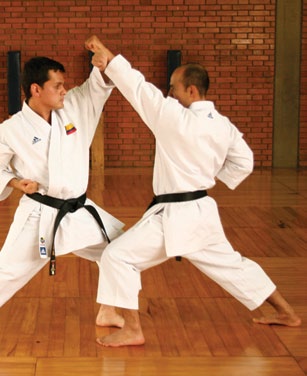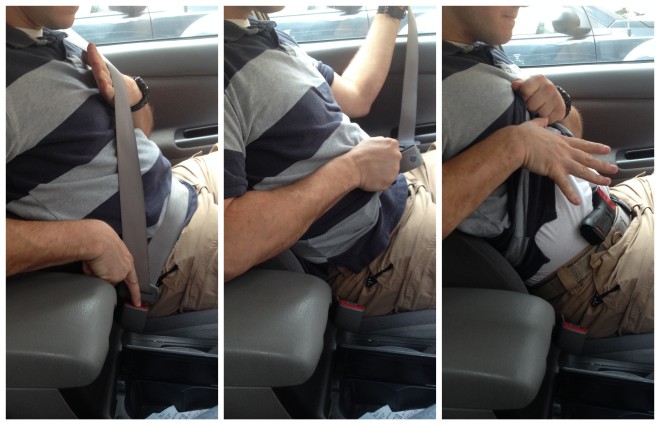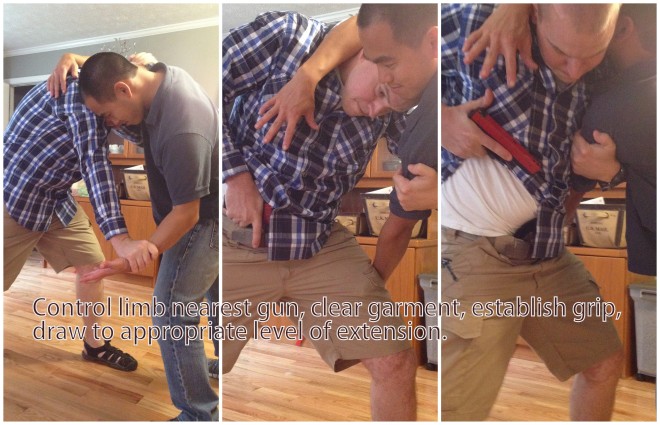“The Draw Stroke is the Draw Stroke is the Draw Stroke.”
-Paul Gomez explaining the drawstroke from several unorthodox positions
Paul Gomez, the personal protection integrator who passed away well before this time, once said that simple phrase that has stuck with me ever since. He was good about quips that you would have to contemplate and reflect on. At the time, the realities of self-defense and ‘The Fight’ were starting to become clearer to me. I realized that if I had to use my gun, I wouldn’t be slapping iron at noon in a dusty street while the town folk were watching from the front of the saloon (Insert your own personal gunfight fantasy).

Upon watching and reading about the dynamics, lighting conditions, circumstances, terrain, distances, number of criminals, and locations in defensive shootings (gun fights, or gun battles) there was only one thing that was consistent. This is that the good guy didn’t get to choose when it went down. We, as the reactionary party, are attacked when it’s the worst possible time for us, and the best possible time for them.
As I wrote about in practice by the odds, a person should spend most of their time/resource constrained practice time working the most likely needed skill sets and streamline their mechanics to cover the widest set of circumstances one possibly can.
Your gunfight (hopefully we get lucky enough to make it a shooting instead) might be at thirty feet in a parking deck, at arms range in bank, in the hallway outside of your child’s room, in the front seat of your car, or on your back next to an ATM. So how can we as responsible and thinking gun owners, try to account for as MANY of these scenarios as possible with one set of mechanics for getting our gun into play? We can’t try to do something different for each scenario and have a different way to get the gun into play for each one. The decision tree quickly branches into an unmanageable (and slow) pile of options. The method of ‘if this, then this’ is why certain martial arts fall apart under pressure.

So we need a draw stroke that works within as many of the scenarios as we can imagine. We need an ‘if anything happens, you only need this one movement’ type of thing. Luckily for me, there are guys like Gomez, Craig Douglas, Greg Ellifritz, Cecil Burch, Chris Fry, James Yeager, Paul Sharp, Larry Lindenman, Aaron Little, and all of the gentlemen and scholars that teach a robust universal draw stroke and it’s integration into a self defense program.
The universal draw-stroke is so useful because with one mechanic we can handle probably 99% of all scenarios that one could imagine. It works while standing, lying, seated, while grappling, in a competition, from appendix or behind the hip, in a retention position, whatever you’ve got.
The Steps
- Clear obstructions which could foul building a full (fuckin’) firing grip. This one can be deceptively complicated. In the simplest case with an open top holster in a shooting range, you can actually skip this step completely. Slightly more complicated might be breaking holster retention devices or clearing concealment garments. If seated, you might have to clear garments and a seat belt. If you’re in a fouled up tangle (gun grapple) of arms and legs, it might mean doing an arm drag and controlling the nearest arm to the gun. This step has the most depth of any of the parts of the draw-stroke. You can go deep deep deep into training all the complications that this one step can cause.
- Establish a full firing grip. Building the grip with all of the proper index points is key. This is the first, and probably last time in your fight that you’ll have to build a good grip. Get a lot of practice and make it count.
- Begin an efficient (no wasted movement) draw in which the gun is never lower than it was a moment before. Keep your elbows from tracking away from your torso. Being in proximity to non-involved parties that you don’t want to hang up on while drawing and opening holes between your arms and your torso for the bad guy to control your arms being the primary reasons.
- Move to an indexed position of retention. This is important because you may need to shoot with someone in contact with you, swinging a pipewrench, or otherwise in your intimate space. If you need to shoot from here, you can stop your draw and begin shooting.
- Move the gun to a horizontal position under the dominant eye. Your hands can come together at this point. Or for one handed shooting, you can begin pressing the gun out to full extension. While the gun is coming out, you should be bringing the gun into the eye-target line as quickly as possible. This gives you time to refine your sight picture as you are reaching full extension, which will allow you to start shooting quicker.
Example Photos:





In Closing
I think spending the time to drill and ingrain this draw-stroke is time well spent. Having the framework to shoot from different positions without having to think about the mechanics is crucial. You’ll have enough other things to think about. When learning this draw, you should seek training under a watchful eye so you learn all the nuance involved. When you’re drilling and learning this draw, strive for perfect repetitions. Try to hit all of the index points so you will have the kinestetic awareness of how your body feels and where it is in space. I would pause at each way point along the way, imagining myself as a robot moving perfectly.
What you’ll probably find is that when you’re going for supreme speed in a competition or when you know you’re shooting at distance, the sharp corners of your draw will ’round’ and you’ll move in a more direct path to the target. That’s OK. You’re a thinking being and you will know when it’s appropriate. Having a framework to fall back on is what matters here. One Draw Stroke to rule them all… or something.
Getting Training
Here’s a list, in no particular order, of some trainers who can teach you this stuff:
- Craig Douglas http://shivworks.com/
- Aaron Little http://www.truthincombat.com/PerformanceEdgeTraining.html
- Cecil Burch http://www.iacombatives.com/
- Greg Ellifritz http://www.activeresponsetraining.net/upcoming-classes
- Chris Fry http://www.mdtstraining.com/
- Paul Sharp http://sharpdefense.me/
- Claude Werner http://tacticalprofessor.wordpress.com/
- Jeff Bloovman http://www.armeddynamics.com/
- James Yeager http://www.tacticalresponse.com/
- Steve Charles http://www.stonyfarmdefense.com/
- Probably many more, any omissions are only because I haven’t personally trained with them.

Great article. I do have one question, though. Do you even sandal, bro? Tactical Jesus FTW.
Lol. At leas they’re not flip flops. Keens Are official dad garb. Respect the sandals!!!
You need to add socks with those sandals. In addition to being super comfortable the bad guys will underestimate you.
HAHA! Gimme a break, man!
Rocking the Air Bethlehem 2’s which Jesus wore in game 7 against the Romans.
And killin’ the game. 😛
Really fantastic tutorial on proper draw technique that deserves much more attention. Thanks for sharing.
Thank you, Sir! I’m glad you enjoyed it. For lots of folks this is old hat and boring, but for many many more it is black magic (but shouldn’t be). Self protection shouldn’t be proprietary in my opinion.
Great job boiling it down to basics. One of my regrets is that I never got to train under Gomez; you do a good job of conveying his essential points.
Thank you, Sir. I’m just trying to share the info freely like Gomez did.
DISCLAIMER: I’m only speaking to the things I’m talking about and nothing else.
” We can’t try to do something different for each scenario and have a different way to get the gun into play for each one. The decision tree quickly branches into an unmanageable (and slow) pile of options. The method of ‘if this, then this’ is why certain martial arts fall apart under pressure.”
If the above quote is true, how does a person using ~the one true draw stroke~ know or decide where along that draw stroke to stop the gun and shoot? A decision will have to be made. How different is a guy thinking” I need to stop at 2 and shoot” from ” i need to draw to 2 and shoot” ?
(please save me the time of explaining that yes, thinking does happen, and no, you are not “just reacting” if we are talking about humans handling firearms)
Thanks for your comment. You’re right, decisions are made and we are certainly able to make decisions in an adrenalized state. I think it comes down to context. If I have 8-16 hours, and I want to give a new defensive shooter the most useful draw that I believe covers the widest range of scenarios, this is what I like to show them. I don’t know you, but I’d be willing to bet you’ve been shooting for quite a while. I’ve been doing training for 9 years, only. I know for a fact when I compete I don’t go directly through the number two position. The edges get rounded off based on what I’m doing. I think that’s what you’re getting at. And since we CAN think we can hurry to the target and get the gun level and start shooting at targets at distance. If we are in an entangled gunfight, We know not to punch the gun out and will hold it into a much tighter two. So in the end, the universal draw stroke it’s about introducing it to novice shooters so that they have to think about the fact that they might have to shoot someone on top of them, they might have to shoot someone within an arms length of them, or they might have to make a Precision shot a distance. I think you’re trying to pigeonhole me into the “we just react we don’t think group “which if you read my blog a little more I think you would find that is not the case. I appreciate your thoughts and it was important to clarify that. Thank you
Thank you for the tips. As a person who studies martial arts and trains with firearms, I can’t over emphasize the need to have some basic martial arts techniques along side your firearms training. I can’t really tell from your pictures, but in a fight in close quarters like the last picture, you are most likely going to need to do more than just isolate the arm closest to the gun. You may have to do some damage to the attacker before you can safely draw the gun, without the attacker taking it from you. You don’t need to be Bruce Lee, but one should know how to do some knees, leverages, elbows etc. That picture on the ground, you are in a position to do a sweep on the guy which would get you into a safer position in which to draw your weapon. I am not sure I would draw if I was under someone, unless it was the last resort. He can certainly over power you being in your guard. So basically, I use my martial arts to buy me time to get to a gun. That is my opinion, but every situation is different and needs split second responses.
For me, choosing to draw my firearm in an attack makes my brain overload on the decision tree because of the legal ramifications of using lethal force. Shooting a gun may be more simple than martial arts, but the split second decisions on life and death we have to make are not. I don’t know how the police do it everyday. Thanks for your article.
Diana, thanks for your comments. You’re absolutely correct in your analysis. I could work a scissor sweep or similar from there. In thousands of evolutions in ECQC, Craig Douglas has termed a phrase “the timing rule” which is that you should, at minimum, have limb control on the nearest arm to your gun. You are the exception to want to strike and grapple to a dominant position before accessing your tools. Most gun folks get tool fixated and end up accessing before they have control. I’d much rather get a sweep to a side control/knee on belly before accessing. Photos are difficult to relay that sort of detail. Thanks for your comment. Cheers.
“For me, choosing to draw my firearm in an attack makes my brain overload on the decision tree because of the legal ramifications of using lethal force.”
This statement makes it clear that you haven’t really internalized a mental position that allows you to use deadly force. This is a very common situation, even for some of those who own, or even carry, a gun. People dance all around this in their thinking. This has to be resolved prior to “enemy action”, or you end up mentally frozen, usually.
The ground work for this position takes time to sort out. You may or may not have done some of the preliminary thinking (most haven’t), and if you end up killing someone attempting to harm you, even if it wasn’t intentional, the mental fallout can be devastating if you haven’t done the homework needed.
First, you must decide if YOU are worth at least as much as anyone else. Alternatively, are the people with you (family, friends, co-workers) worth that, even if you don’t think you are. (this sort of thinking is more common than you would suspect, unfortunately)
” I am not sure I would draw if I was under someone, unless it was the last resort.”
If you are grappling with someone, you are drawing the gun with the intention of shooting them. If it wasn’t a deadly force situation prior to your draw, it sure as hell will become one after you introduce a gun into his perception and reach. Once your opponent sees the gun, they will go all out to destroy you. They MAY decide to bail instantly, but that is not the way to bet your life on. Expecting them to go all docile when they see a gun pointed at them is very very stupid thinking. This is especially true for a female, as the attacker’s ego is going to rear it’s ugly head, if it hasn’t already (you’re fighting, right?).